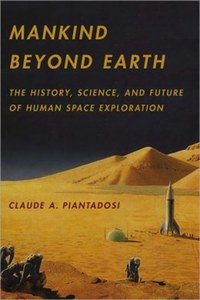Review: Mankind Beyond Earthby Jeff Foust
|
| At first glance, Mankind Beyond Earth looks rather retro: the Chesley Bonestell cover art, the font, even the title (“Mankind” versus, say, “Humanity”). |
Of the three parts, the second is perhaps the strongest. Piantadosi goes into great detail about the issues humans face attempting to live beyond Earth, such as developing robust, closed-loop life support systems and countermeasures to keep astronauts healthy after extended exposure to microgravity. The biggest obstacle, he argues, is cosmic radiation, since unlike other issues of human exposure to the space environment, there is no clear solution regarding how to protect people from the exposure to this radiation. “The only practical strategy is to keep radiation exposures as low as reasonably achievable,” he concludes (emphasis in original.)
The first and third parts of the book, though, are much weaker. The first part is a mix of history (of spaceflight and terrestrial exploration) that tries to make the case for returning to the Moon, “the only place large enough and close enough to implement a long-term strategy for interplanetary space exploration involving people.” But beyond describing the advantages of lunar settlements—their proximity to Earth, available resources, and so on—he doesn’t make much of a case for going there that hasn’t already been made, unsuccessfully, in the past, such as during the Vision for Space Exploration. The third part is no better, growing more speculative as he examines human exploration into the outer solar system and even to other solar systems.
Piantadosi is clearly an expert on human factors, and in that section of the book he dives into specifics about the issues that humans facing trying to live in space. In fact, it may be too much detail for the casual reader. However, his knowledge of other aspects of spaceflight doesn’t appear to be quite as good, as the book contains a number of surprising errors. For example, in several cases he refers to former astronaut “Harrison Schmidt” who flew to the Moon on Apollo 12; Harrison Schmitt, of course, was on the crew of Apollo 17. Others are fallacious leaps of logic: “Yet today, NASA has no heavy-lift launch capability. Thus we are now paying the Russian Federation to transport our people to the ISS,” he writes. The two sentences are true with the exception of the use of “thus”: while NASA has no heavy-lift capability, it is not necessarily relevant to human spaceflight; the Russian Soyuz vehicle, after all, is not a heavy-lift vehicle.
As for a rationale for human spaceflight strong enough to shake loose public or private dollars, Mankind Beyond Earth doesn’t offer much. He is not fond of arguments that humanity should establish a presence beyond Earth to ensure its survival, concluding that the odds of our being wiped off the Earth by a natural cataclysm to be “vanishingly small” (the odds that we might wipe ourselves out are perhaps a bit larger, but he doesn’t dwell much on that possibility.) “The best course of action seems to be to learn as much as possible about our place in the universe while trying to avoid killing ourselves,” he concludes near the end of the first part of the book. Good advice, to be certain, but one that doesn’t explicitly require humans to leave the Earth.
